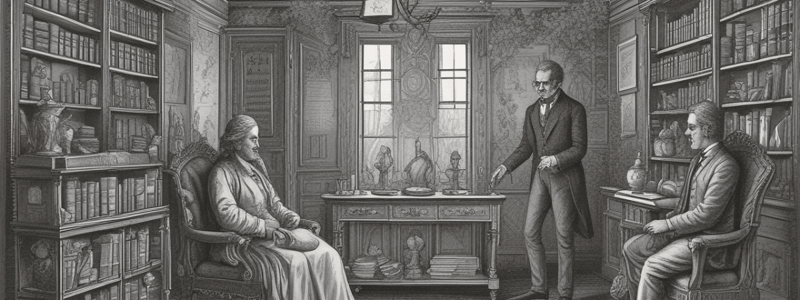Podcast
Questions and Answers
What was the primary goal of the Lunacy Act of 1890?
What was the primary goal of the Lunacy Act of 1890?
- To establish a system for appointing medical officers to examine suspected mentally deficient individuals (correct)
- To abolish the use of phrenology in psychiatric diagnosis
- To reduce the number of asylums in England and Wales
- To promote the use of electroconvulsive therapy in mental institutions
What was a significant outcome of the Lunacy Act of 1845?
What was a significant outcome of the Lunacy Act of 1845?
- The development of phrenology as a widely accepted psychiatric practice
- The requirement for all counties and principal boroughs to make provisions for the care of lunatics (correct)
- The establishment of Bethlem Hospital as a national psychiatric institute
- The creation of a national mental health policy for the Victorian era
What is Bethlem Hospital also known as?
What is Bethlem Hospital also known as?
- Bedlam (correct)
- The London Lunatic Asylum
- The Victorian Mental Hospital
- The Royal Psychiatric Institute
When was Bethlem Hospital founded?
When was Bethlem Hospital founded?
What is NOT mentioned in the text as a significant event in the history of British psychiatry?
What is NOT mentioned in the text as a significant event in the history of British psychiatry?
In which era did the reform of Bethlem Hospital take place?
In which era did the reform of Bethlem Hospital take place?
What was a significant outcome of the Lunacy Act of 1845?
What was a significant outcome of the Lunacy Act of 1845?
What was the primary focus of the York Retreat?
What was the primary focus of the York Retreat?
What was the name of the theory that held that the contours of the skull could be used to determine mental abilities and character traits?
What was the name of the theory that held that the contours of the skull could be used to determine mental abilities and character traits?
What was a key characteristic of the development of psychiatry in Britain during the Victorian era?
What was a key characteristic of the development of psychiatry in Britain during the Victorian era?
What was the purpose of the asylums established as a result of the Lunacy Act of 1845?
What was the purpose of the asylums established as a result of the Lunacy Act of 1845?
What was the outcome of the changes in the legal system and the establishment of new institutions during the Victorian era?
What was the outcome of the changes in the legal system and the establishment of new institutions during the Victorian era?
Flashcards are hidden until you start studying
Study Notes
British History of Psychiatry: Lunacy Act, Bethlem Hospital, Asylum Reform, Phrenology, and Psychiatry in Victorian Era
Lunacy Act
The Lunacy Act of 1890, also known as the Mental Deficiency Act, was one of the last acts passed in Parliament during the Victorian era. This act aimed to address the issue of "criminal lunatics" by regulating the care and treatment of individuals with mental disabilities. The act established a system whereby local authorities could appoint medical officers to examine those suspected of being mentally deficient, and if necessary, place them in institutions for care and treatment.
Bethlem Hospital
Bethlem Hospital, also known as Bedlam, is one of the oldest psychiatric hospitals in the world. It was founded in 1247 in the City of London and is now known as the Bethlem Royal Hospital. Over the years, it has played a significant role in the history of British psychiatry. In the late Victorian era, the hospital underwent significant reforms and changes in its management and treatment methods.
Asylum Reform
The Lunacy Act of 1845 was a turning point in the history of British psychiatry. It required all counties and principal boroughs in England and Wales to make provisions for the care of lunatics, leading to an unprecedented period of asylum construction. This act fundamentally changed the foundation of care for the mentally ill by replacing the practice of placing them in prisons or workhouses with institutions specifically designed for them.
Phrenology
Phrenology was a popular pseudoscientific theory in the Victorian era that held that the contours of the skull could be used to determine mental abilities and character traits. This theory, developed by Franz Joseph Gall in the late eighteenth century, was widely practiced in Britain during the early and mid-nineteenth century, despite being discredited by scientific evidence.
Psychiatry in Victorian Era
During the Victorian era, psychiatry in Britain underwent significant changes, both in terms of professionalization and the establishment of care institutions. The period was marked by a growing interest in mental health and a shift from a focus on punishment and control to one of care and treatment. This change was driven by a combination of factors, including the Lunacy Act of 1845, which required counties to establish asylums for the care of lunatics, and the influence of the York Retreat, a Quaker institution founded in 1796 that focused on humane treatment of the mentally ill.
In conclusion, the history of psychiatry in Britain during the Victorian era was marked by significant changes in the legal system, the establishment of new institutions, and the development of new theories and practices in the field. These changes laid the foundation for the modern psychiatry that exists today.
Studying That Suits You
Use AI to generate personalized quizzes and flashcards to suit your learning preferences.





